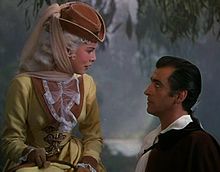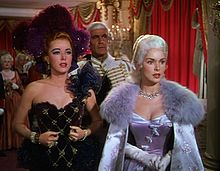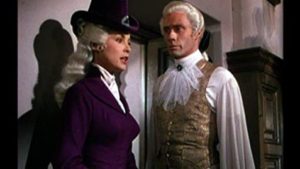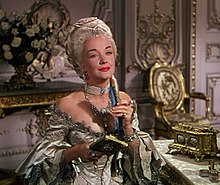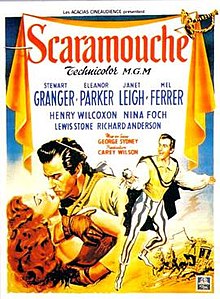Scaramouche **** (1952, Stewart Granger, Janet Leigh, Eleanor Parker, Mel Ferrer) – Classic Movie Review 9883
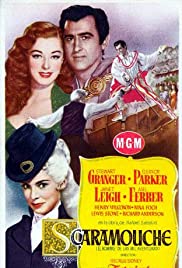
Director George Sidney’s 1952 MGM rip-snorting Technicolor adventure tale Scaramouche is based on the 1921 novel by Rafael Sabatini and has main star Stewart Granger swashing a florid buckle as André-Louis Moreau, who needs to wreak vengeance on the murderous Noel, the Marquis de Maynes (Mel Ferrer) in 1780s France.
Among the many reasons to watch are the sprightly cast (with good parts for Eleanor Parker as Lenore and Janet Leigh as Aline de Gavrillac), an epic climactic sword fight (with Granger doing all his own stunts), and a busy, fast-moving plot, matched by colourful direction from George Sidney.
This zesty humdinger hit from MGM’s impressive cycle of Fifties swashbucklers is noted for its intensity and excellence, and is top rate of its kind.
The spectacular seven to eight-minute-long duel in the theatre between Moreau and de Maynes is reputedly the longest in screen history and took eight weeks to prepare, including memorising 87 fencing passes. Granger took fencing lessons from Jean Heremans, but even so ended up with a wrenched knee, a damaged shoulder and an injured back.
It was Rex Reason’s debut, aged 24, as Edmond (uncredited). The lookalike actor Rhodes Reason (1930–2014) was the younger brother of Rex Reason (1928–2015).
It was previously filmed by Rex Ingram as the 1923 silent Scaramouche with Ramón Novarro. Lewis Stone played the Marquis de la Tour d’Azyr in the original and plays Georges de Valmorin here.
Last film of London-born character actress Elisabeth Risdon (1887-1958), whose debut 142 films earlier was Maria Marten in 1913.
The screenplay is by Ronald Millar and George Froeschel, based on the 1921 novel Scaramouche by Rafael Sabatini, as well as the 1923 film version starring Ramón Novarro.
Nina Foch appears as Marie Antoinette, wearing the same costume as Norma Shearer did in MGM’s 1938 film Marie Antoinette.
Also in the cast are Henry Wilcoxon, Nina Foch, Lewis Stone, Robert Coote, Richard Anderson, Elisabeth Risdon, Howard Freeman, Curtis Cooksey, John Dehner, John Litel, Jonathan Cott, Dan Foster, Owen McGiveney, Hope Landin, Frank Mitchell, Carol Hughes, Richard Hale, Barrie Chase, Henry Corden, John Crawford, Douglass Dumbrille, John Eldredge, Bert LeBaron, Mitchell Lewis, Anthony Marsh, Ottola Nesmith, Dorothy Patrick, Rex Reason, John Sheffield, William Tannen, and Frank Wilcox.
It was shot for a hefty budget of $3,500,000 mainly in the Metro-Goldwyn-Mayer Studios, Culver City, California. But it earned $6,746,000, making a profit of $1,062,000.
Mel Ferrer recalled: ‘MGM asked me if I fenced, and I told them “no, I’m a dancer”. I learned how to fence in six weeks. We did seven duels in the picture, and each one was different. We never repeated a sequence. And that’s like learning seven ballets. It’s very, very difficult.’
Eleanor Parker recalled: ‘Stewart Granger was a dreadful person, rude, just awful. All of the dueling scenes in Scaramouche were wonderful, though. I’ll give Granger credit for that. Mel Ferrer was extremely adept at the swordplay, but was a gentleman.’
Scaramouche is directed by George Sidney, runs 115 minutes, is made and released by MGM, is written by Ronald Millar and George Froeschel, based on the novel by Rafael Sabatini, is shot in Technicolor by Charles Rosher, is produced by Carey Wilson, and is scored by Victor Young.
© Derek Winnert 2020 Classic Movie Review 9883
Check out more reviews on http://derekwinnert.com

